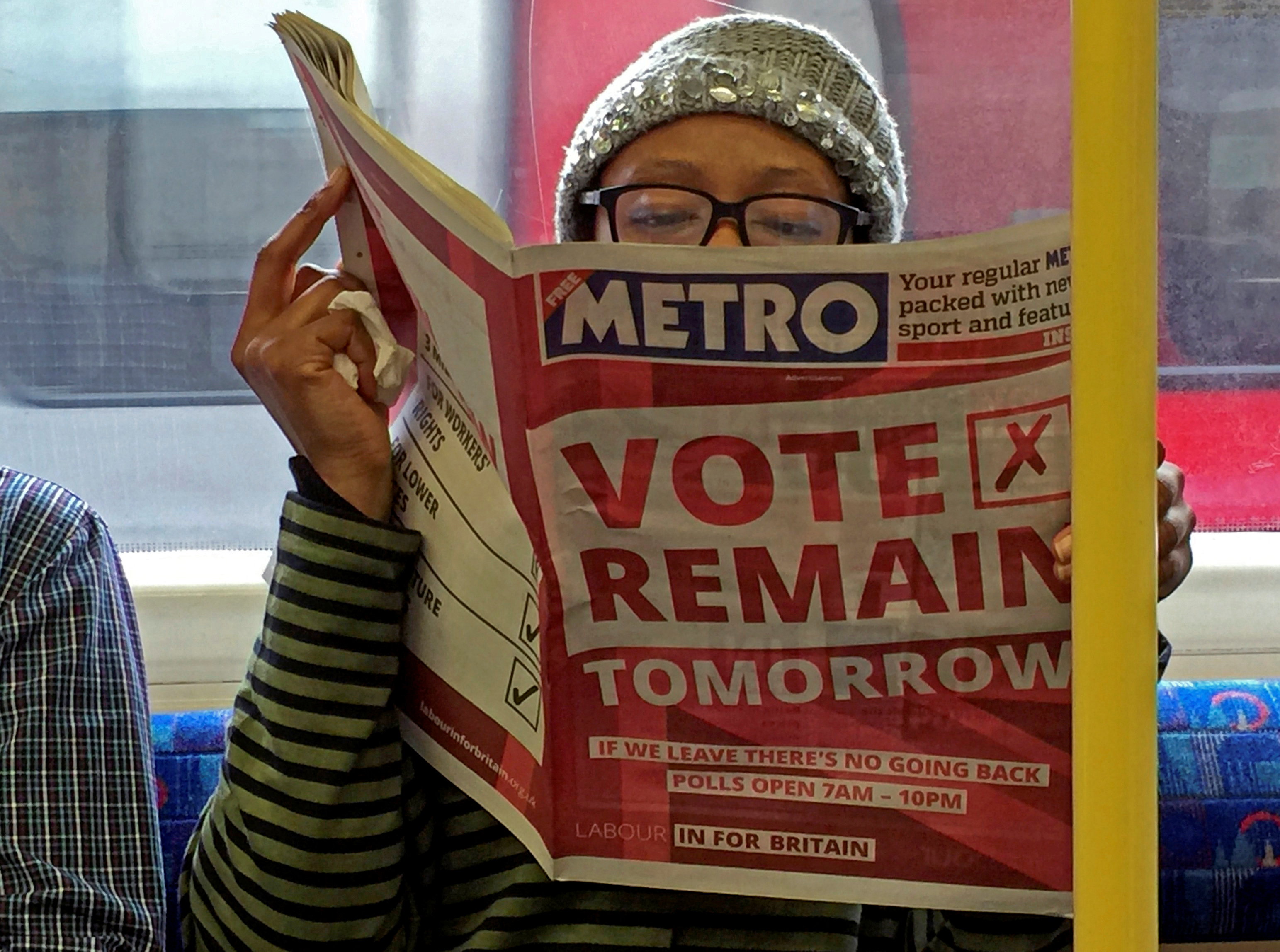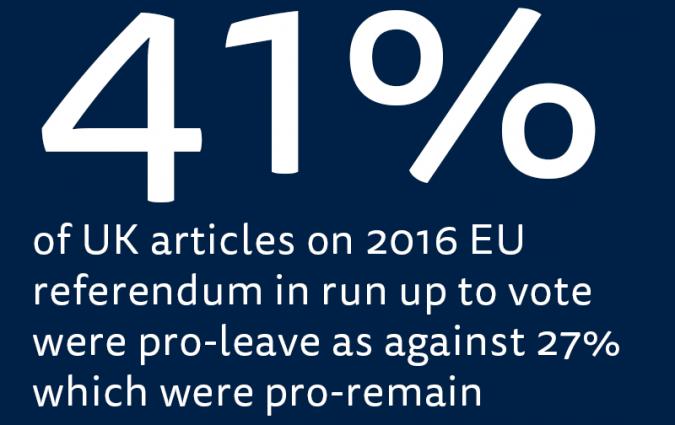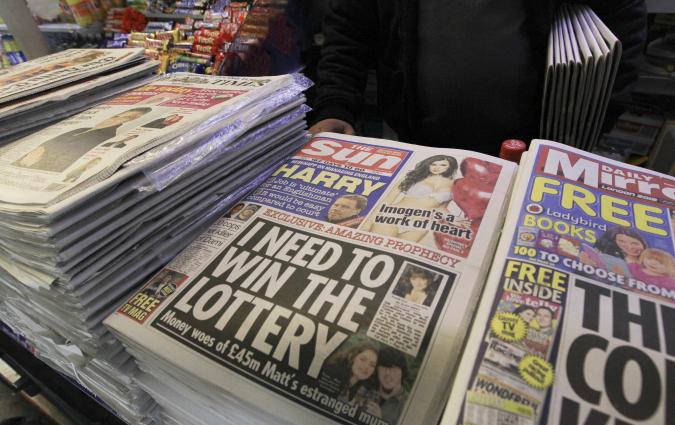In this piece
How Brexit referendum voters use news

A woman reads a newspaper in London during the EU referendum campaign. REUTERS/Russell Boyce
In this piece
Introduction | Key findings | Main Sources of News | The Use of Specific News Outlets | Trust in Specific News Outlets | Polarized News Use | Using Social Media for News | Footnotes | ReferencesDOI: 10.60625/risj-yeq6-4m46
Introduction
It’s been over three years since the United Kingdom narrowly voted to leave the European Union in June 2016 – and the role the news media played during the referendum campaign, and during the subsequent negotiations, continues to be debated.
People ask, for example, whether new forms of online communication swung the result in favour of leave, whether parts of the news media are structurally biased towards a particular worldview, and whether people’s understanding of the EU has been shaped by decades of partisan coverage. The scope and magnitude of these questions can be daunting – especially given that we lack basic facts about how those on different sides typically access news.
In this factsheet, we have compared the current media habits of those who voted to remain with those who voted to leave. In doing so, we uncover patterns that challenge some widely held assumptions.
Key findings
- Both leave voters and remain voters mainly access news offline via print, television and radio. 71% of leave voters say they mainly access news offline, compared to 55% of remain voters.
- Remainers are more likely to use The Guardian, The Times, the Mirror, and HuffPost for news. Leavers are more likely to access news from The Sun, Daily Mail, Sky, and ITV. But by far the most popular outlet with both groups is BBC News.
- Remain voters have higher average trust in outlets like The Guardian and the Independent, whereas The Sun and Daily Mail are more trusted by leave voters. Across both groups, broadcasters and broadsheet newspapers are the most trusted outlets in our sample.
- If we focus on newspapers with a clear position on Brexit, only a tiny proportion of leavers (3%) and remainers (1%) get all of their news from either a pro-leave or pro-remain outlet.
- There is little difference in social media news use between leavers and remainers, with the exception that those who voted remain are more likely to use Twitter.
These insights come from the 2019 Reuters Institute Digital News Report (Newman et al. 2019). The report is based on an online survey of news users, carried out by YouGov in 38 markets, including the UK, in February 2019.1 Although the survey focuses on news use, we can combine the data with information about if/how the respondents voted in the 2016 referendum on the UK’s membership of the EU.2
It is important to make clear that this study looks at the news habits of voters in February 2019, and not during the campaign in 2016. That being said, the data can in some cases be used to make reasonable inferences about people’s news use from three years ago, given that recent polling shows that ‘very few voters on either side of the argument have changed their minds about whether the UK should leave the EU’ (Curtice 2019).3 Although polling also suggests that if there was a referendum tomorrow there would be a narrow remain victory, ‘this lead for Remain rests primarily on the views expressed by those who did not vote three years ago’ (Curtice 2019).
Main Sources of News
Looking at the data in more depth shows those who voted remain are more likely to say that their main source of news is online (including social media) (45%). Leave voters have a particularly strong preference for television, with over half (51%) saying in 2019 that TV is their main source of news (see Figure 1). If we group together print, radio and television we see that a majority of both leave voters and remain voters say that traditional offline news access is their main way of getting news. However, the preference of leave voters is stronger, with 71% saying that this is their main way of accessing news, compared to 55% among remainers. This is partly linked to age, given that older people are both more likely to have voted leave and less likely to access news online (Newman et al. 2019) – but nonetheless it is important to keep this in mind when trying to understand the impact of online media on those that voted leave.
The Use of Specific News Outlets
The preference among leave voters for television is reflected in the cross-platform use (online combined with offline) of specific news outlets. They are more likely to use commercial broadcasters like Sky News and ITV, as well as right-leaning tabloid/mid-market publications like The Sun, Daily Mail, and Daily Express (see Figure 2). Remainers are more likely to turn to left-leaning newspapers like the Mirror and The Guardian, as well as digital-born outlets like HuffPost and BuzzFeed. Crucially, however, the most widely used news outlet by both camps is the BBC. It is used weekly by over three-quarters of all voters, but is more popular with remainers (85%) than leavers (78%).
To some extent, these patterns of media use map onto previous research showing that The Sun, Daily Mail, and Daily Express produced more pro-leave coverage during the campaign, and that The Guardian, Mirror, and FT were pro-remain (Levy et al. 2016; Deacon et al. 2016b). However, there are also some exceptions. The main commercial television channels produced relatively balanced coverage during the campaign (Deacon et al. 2016a), but they are now favoured by those that voted leave. Similarly, the Telegraph predominantly published pro-leave coverage during the campaign, but is now used to a roughly equal extent by remainers and leavers. The way some newspapers covered the referendum, and their readership, will have changed slightly in the three years since the vote (Brandenburg 2019). Furthermore, we should remember that while Brexit has dominated the news agenda in recent years, it is far from the only reason people choose certain news outlets over others.
Trust in Specific News Outlets
We see a similar pattern if we look instead at how much remainers and leavers trust certain news outlets. We asked respondents to rate how much they trust news from specific outlets on a scale ranging from completely untrustworthy (0) to completely trustworthy (10). As expected, outlets with higher average trust among those who voted remain include those – like The Guardian (6.73) and Independent (6.56) – that were pro-remain, whereas for The Sun (4.43) and Daily Mail (5.45), trust is higher among leavers.
Commercial broadcasters Sky and ITV have broadly similar levels of news trust from both groups, but for the BBC and Channel 4, the figures for leavers are significantly lower – though, still relatively high compared to other outlets. In general, regardless of whether people voted leave or remain, television brands and broadsheet newspapers tend to have high levels of trust, whereas tabloids and digital-born brands have lower levels.
Polarized News Use
A key concern in recent years is whether people are now, more likely than before, to only see news and information representing a single partisan point of view. If true, this could be due to people intentionally becoming more selective because they have become less tolerant of opposing views, or it could be because the selection decisions made by algorithms on search engines and social media, narrow the range of views people are exposed to. There is some evidence that people formed Brexit ‘echo chambers’ on Facebook during the campaign (Del Vicario et al. 2017). This is important to acknowledge but, at the same time, it’s not clear what this implies about people’s media use as a whole because almost no one is solely reliant on social media for news (Dubois and Blank 2018).
Looking first at newspapers that content analysis has found to be pro-remain (Guardian, Mirror, and the FT), we see that, although 42% of remain voters used at least one of these in the previous week, just 1% did not additionally use at least one of the other outlets listed in Figure 2. The story is similar for leavers. Over half (58%) said they had used either The Sun, Daily Mail, Daily Express, or the Telegraph, but just 3% got all of their news from one or more of these sources (see Figure 3). These findings are in line with our previous research showing that there is a high degree of audience overlap between the most popular news outlets (Fletcher and Nielsen 2017).
One of the main reasons for these surprisingly low numbers is the widespread popularity of BBC News. Because the reach of the BBC is so large, around 75% of all UK news users access BBC News each week, meaning that the vast majority of those that voted in the referendum regularly come into contact with at least one relatively impartial source.
Using Social Media for News
When we look at social media, we mostly see only small differences between leavers and remainers in terms of what social networks they use for news. The exception is Twitter, which is used for news by 18% of remain voters, compared to 10% of leave voters (see Figure 4). For other social networks, the differences are smaller and not statistically significant in most cases. Facebook, the most popular social network for news in the UK, is used by a similar proportion of remainers (26%) and leavers (29%) for news.
If we look at what people do on social media, we again see only very small differences – but remain voters are now slightly more active around news. One in five remainers (20%) say that they share news on social media in a typical week, compared to 16% of leavers (see Figure 5). When it comes to commenting on news on social media, there’s no statistically significant difference between the two groups. This does not necessarily mean that there is an equal amount of leave and remain content on social media. In fact, evidence from Twitter shows that leave hashtags were used more frequently during the campaign, though this could be due to the influence of bots (Howard and Kollanyi 2016).
Of course, these findings only offer a partial picture of the role of the news media during the discussions that followed the referendum, and do not speak directly to some of the specific concerns. Yet, they do begin to cast doubt on some of the more simplistic accounts that see the outcome as a direct result of the news and information people see online. They remind us that traditional offline access is still the most important way that most people get news, and any analysis of the impact of the media on politics needs to consider online and offline use together.
Footnotes
1 More information about the 2019 Digital News Report can be found at: www.digitalnewsreport.org
2 If/how each respondent voted in the EU referendum was not identified during the 2019 Digital News Report survey. This was collected at an earlier date by YouGov as part of the information they store on their panellists, and later merged with the 2019 survey responses. This means that the vote data are likely to be more accurate because they were collected closer to polling day, but also that voting data were not available for all respondents. Referendum vote data were available for 1805 of the 2023 survey respondents (89%). These data contain responses from 741 remain voters and 877 leave voters. The 168 respondents who did not vote in the referendum, and the 19 respondents who could not remember if they voted, were excluded from the analysis.
3 More precisely, ‘88% of those who backed remain would do so again [and] among those who voted leave, 86% have not changed their minds’ (Curtice 2019).
References
- Brandenburg, H. (2019). ‘What do British Newspaper Readers Think about Brexit?’, LSE Brexit (blog). 12 July.
- Curtice, J. (2019). ‘Have UK Voters Changed their Minds on Brexit?’, BBC News, 15 Oct.
- Deacon, D., Harmer, E., Downey, J., Stanyer, J., and Wring, D. (2016a). UK News Coverage of the 2016 EU Referendum (Report 4). Loughborough: Loughborough University.
- Deacon, D., Harmer, E., Downey, J., Stanyer, J., and Wring, D. (2016b). UK News Coverage of the 2016 EU Referendum (Report 5). Loughborough: Loughborough University.
- Del Vicario, M., Zollo, F., Caldarelli, G., Scala, A., and Quattrociocchi, W. (2017). ‘Mapping Social Dynamics on Facebook: The Brexit Debate’. Social Networks, 50: 6–16.
- Dubois, E., and Blank, G. (2018). ‘The Echo Chamber is Overstated: The Moderating Effect of Political Interest and Diverse Media’, Information, Communication and Society, 21(5), 729–45.
- Fletcher, R., and Nielsen, R. K. (2017). ‘Are News Audiences Increasingly Fragmented? A Cross-National Comparative Analysis of Cross-Platform News Audience Fragmentation and Duplication’. Journal of Communication, 67(4), 476–98.
- Howard, P. N., and Kollanyi, B. (2016). Bots, #StrongerIn, and #Brexit: Computational Propaganda during the UK EU Referendum. COMPROP Research Note 2016.1. Oxford: Oxford Internet Institute.
- Levy, D. A. L., Aslan, B., and Bironzo, D. (2016). UK Press Coverage of the EU Referendum. Oxford: Reuters Institute for the Study of Journalism.
- Newman, N., Fletcher, R., Kalogeropoulos, A., and Nielsen, R. K. (2019). Reuters Institute Digital News Report 2019. Oxford: Reuters Institute for the Study of Journalism.
Published by the Reuters Institute for the Study of Journalism.

This report can be reproduced under the Creative Commons licence CC BY. For more information please go to this link.



